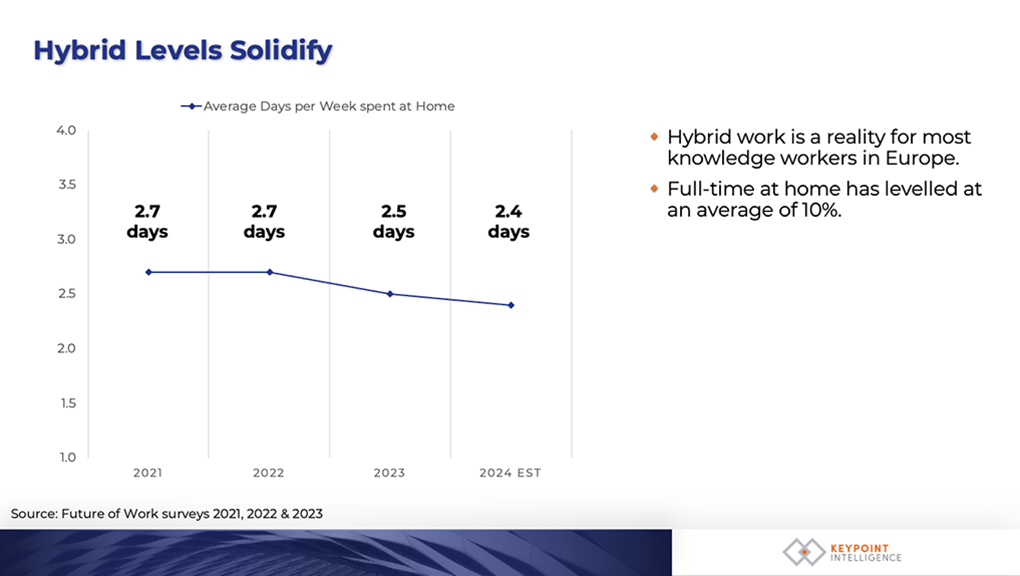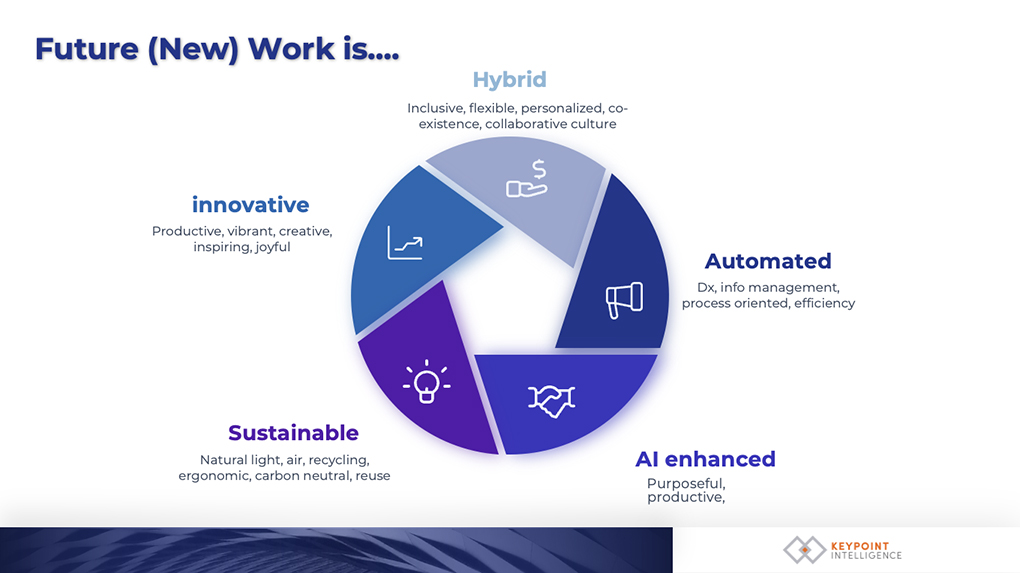Where AI Fits in Workspaces of the Future
Where AI Fits in Workspaces of the Future
[By Deborah Hawkins with contributions from Mark Davis and Keith Haas]

The dynamics of work and the workspace have undergone a fundamental change since 2020. Although the days of pandemic-induced lockdown are, thankfully, becoming a distant memory, we have seen the rise of a new concept in their wake and a new word to enter the lexicon of work: hybrid.
Hybrid working – working from the office and at home during the week – has become a norm for most knowledge workers globally with workspace-related technology needs, adapting to suit this form of working. Due to its nature, hybrid working is very much the reserve of knowledge workers who can work from home.
Now that it has become a staple for this section of the workforce, employers and landlords face the challenge of selling the appeal of the office to their hybrid workers. Many have invested in making their office spaces appealing to hybrid workers and adapting their hardware and software infrastructure for the practicalities of working this way.
For those without a permanent office space but who want the option of working from an office, coworking spaces are appealing to this section of the workforce. Despite the high-profile fall of WeWork, coworking is growing in acceptance and space. Arguably, the world of work has never been static, always adapting to new trends and technologies to enter the market, and the era of hybrid working is no different.
Hybrid Working: The Best Of Both Worlds?
Hybrid working levels have solidified over the last year, and most businesses recognize that investment must be made to make workspaces more attractive for current and prospective employees. Today’s labour market, coupled with the recent media coverage around “quiet quitting”, has forced businesses to change how they accommodate employees.
It is no longer acceptable to simply provide a physical space in which to work; businesses must “sell” the value proposition of the space they offer if they wish to attract – and retain – the best. Flexibility is increasingly becoming a top priority for workers as one of the key non-negotiables job seekers seek in hybrid work opportunities.
The evolution of leadership in a hybrid work environment demands a careful approach, prioritizing outcomes over presence and nurturing trust and autonomy among a dispersed workforce. In other words, leaders must be adept at managing teams remotely to maintain team cohesion while also being sensitive to the challenges team members might face when working remotely.
It’s important to remember that such generalities around this nuanced topic do not capture the full picture. Return to work policies after the COVID-19 lockdowns varied depending on companies, job roles, and the nature of the vertical. Some companies, mostly in the financial sectors, mandated full-time return to the office. In contrast, others implement a policy but do not enforce it or do not have a policy at all.
On average, up to 50% of knowledge workers across North America and Western Europe have some level of hybridity in their role, which is a substantial increase compared to pre-pandemic levels. Or, at least, employees saddled with full-time mandates have greater flexibility to make up time when life strikes.

Hybrid work levels solidify at 2.4 days per week – source: KPI Future of Work Surveys 2021, 2022, 2023.
The level of flexibility in hybrid work can vary depending on the face time organizations need from their employees. It is up to employers to figure out whether or not a structured hybrid model or a flexible hybrid model would work. Structured hybrid models enforce predefined days or hours for in-office work (i.e. being required to work in the office from Tuesday to Thursday and working remotely on Mondays and Fridays), offering predictability and simplifying coordination for in-person activities.
While this model ensures regular team interactions and efficient resource management, employees have less flexibility for individual work preferences. On the other hand, flexible hybrid models empower employees with the autonomy to choose their work locations more freely. This flexibility can boost job satisfaction and productivity by accommodating personal schedules and reducing commute times. This can also come at a cost, as this may pose challenges for spontaneous team collaborations and maintaining a connected team dynamic. To reiterate, choosing between structured and flexible models depends on the company’s operational needs, culture, and the nature of its work.
The Future of Work Looks Like…
Employees are now benefitting from investments made to workspaces, and print OEMs and channel members are also investing in the workplace again following the pandemic. These investments primarily focus on modernizing and increasing digital processes. For example, product portfolio offerings have evolved in response to workplace changes and many devices in the A4, A3 (MFP), and scanner markets now offer devices that aid flexible working through greater cloud functionality, reduced footprints, and increased scope for recycled or remanufactured devices. Here are some of the key areas technology providers are considering when looking at the workspace holistically:
Hybrid: Splitting working time between the office and home is established, but maintaining the flexibility and collaboration required by knowledge workers must be at the top of businesses’ priorities. Workers have found that collaboration with colleagues hasn’t been the same since hybrid work has become more of a mainstay, so business leaders need to make sure that teams can effectively communicate with one another and find ways to network with peers and management.
Innovation: The future of work is about innovation aimed to captivate the audience – that being the workforce or the technology customers. Tomorrow’s workplace must be vibrant and creative, inspiring and joyful so that workers will want to go there and be amongst their peers.
Sustainability: Companies can bolster their corporate social responsibility (CSR) efforts by showcasing their commitment to promoting a greener way of operating. Businesses are already implementing sustainability-related goals and policies, but research shows that this is not always a leading investment discussion for businesses, particularly during current economic and geopolitical difficulties.
AI Enhancement: AI and automation have already changed how people work and interact with technology, and they will continue to do so as their capabilities advance rapidly. It will undoubtedly evolve over the coming years with the uptake of generative AI tools and greater deployment of integrated AI in devices such as printers and scanners.
Automation: Other companies might have their strongest focus on automation, which focuses on process optimisation and efficient information management. Digital automation tools can tirelessly work behind the scenes to ensure operations run smoother and faster than ever, saving workers valuable time for work that matters. The larger the company, the greater the need there is to automate their processes.
Data Security and Privacy: As the workforce becomes more digitally connected, safeguarding data and privacy becomes more paramount than it’s ever been. Companies must implement robust cybersecurity measures, including but not limited to secure VPNs, two-factor authentication, and regular security training for employees. Additionally, there is an increased need for there to be clear policies on data handling and privacy.

Over time, if executed strategically, businesses that invest in their future workplaces and digitize their processes can significantly reduce printing, storage, and office space costs. By moving to digital records and utilizing online platforms for collaboration and communication, companies can save on physical resources and reduce overhead expenses while identifying and addressing inefficiencies.
It goes without saying that the adoption of solutions that run on or are enhanced by AI is becoming an integral play for businesses looking to improve their digitization efforts.
With promises leading to reduced costs, improved accuracy, increased efficiency, and enhanced compliance, why wouldn’t businesses reap the benefits? We can already see it seep into workplaces, between flashy Generative AI tools like OpenAI’s ChatGPT and Google Gemini, as well as established tools focused on digitization with Robotic Process Automation (RPA) and Intelligent Document Processing (IDP).
According to Keypoint Intelligence research, the top five processes organizations leverage IDP for revolve around generating reports, invoice processing, customer billing, customer communications, and onboarding. These are all document-oriented tasks that would benefit from AI-driven automation to better support a hybrid workforce. Beyond that, AI can improve print and device management by enhancing tasks like document preparation, job data entry, job scheduling, analysing user print habits, automating supplies replenishment, and regularly performing predictive maintenance.
Having a more digitized infrastructure also helps organizations be more flexible in terms of scalability. As businesses grow, their digital infrastructure should ideally grow with them and effortlessly adapt to their evolving needs. Enabling employees to continue to adapt ensures that businesses will be ready to seize new opportunities.
As we navigate the evolving landscape of future workspaces, it is evident that the future is hybrid, dynamic, and technologically integrated. The transition of hybrid working models, characterized by a blend of office and remote work, marks a significant shift in how businesses and employees approach productivity and collaboration. Businesses are now tasked with creating work environments that are not only functional but also appealing and sustainable, catering to their employees’ diverse needs and preferences to the best of their ability. As the blend of working in-office and remotely becomes more commonplace, businesses must figure out how to face challenges such as fostering team cohesion, individual autonomy, and productivity.
By embracing hybrid work and the different areas of technological innovations and structural changes, the future of work promises organizations that invest in themselves and their employees will benefit by adapting to the constantly changing working landscape with agility and foresight. Having the ability to do so ensures that these businesses can stay ahead of their competitors, setting an example of what a successful future workplace model looks like.
 Deborah Hawkins, the author of the article “Where AI Fits in Workspaces of the Future”, is the Group Director of the Workplace Team at Keypoint Intelligence. She is an industry analyst with strong organisational and project management skills. She is fluent in English and German and has been active in the document imaging and printing industry since 1989.
Deborah Hawkins, the author of the article “Where AI Fits in Workspaces of the Future”, is the Group Director of the Workplace Team at Keypoint Intelligence. She is an industry analyst with strong organisational and project management skills. She is fluent in English and German and has been active in the document imaging and printing industry since 1989.
Hawkins is currently focused on technology in the office environment, drawing on her expertise in hardware, software and services from input to output. Her large knowledge base of market research includes experience in market sizing, forecasting, competitive analysis, online, focus group, and CATI survey work. She can be contacted by email.
Related:
Comment:
Please add your comments below about this article, “Where AI Fits in Workspaces of the Future.”



Leave a Comment
Want to join the discussion?Feel free to contribute!